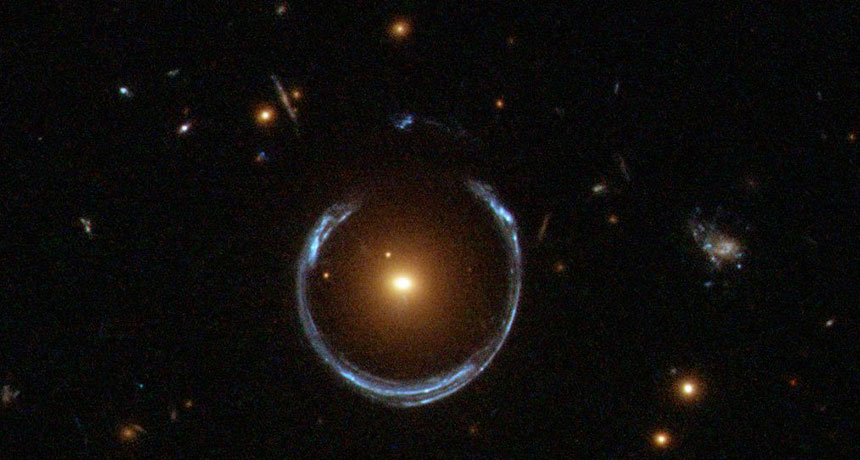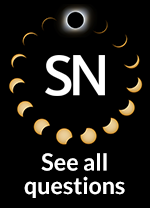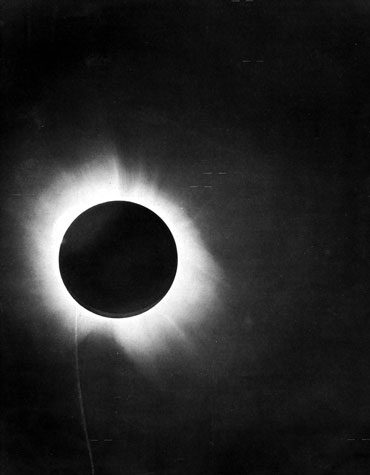
TRICK OF THE LIGHT Einstein showed that spacetime warps around massive bodies and makes light take different paths, as shown in this stellar smile in which a red galaxy distorts the light from a more distant blue galaxy.
ESA/Hubble, NASA
- More than 2 years ago
 Almost a century ago, a solar eclipse revealed the geometry of spacetime. Now, physicists and amateur astronomers — armed with do-it-yourself gear — are going to double check that math during the Aug. 21 solar eclipse.
Almost a century ago, a solar eclipse revealed the geometry of spacetime. Now, physicists and amateur astronomers — armed with do-it-yourself gear — are going to double check that math during the Aug. 21 solar eclipse.
In his 1915 general theory of relativity, Albert Einstein predicted that the sun’s gravity should distort spacetime in its vicinity. Stars behind the sun would appear in different positions with respect to each other during an eclipse than they would on an ordinary night when the sun is nowhere in sight.
The theory marked a revolution in physics, transforming the universe from a static, unchanging landscape to a dynamic, malleable playground.
Just four years later during the May 1919 solar eclipse, British astronomer Arthur Stanley Eddington took photographs that proved Einstein right. “Lights all askew in the heavens,” blared the Nov. 9 New York Times in one of the most famous science newspaper headlines ever. Its subtitle: “Men of science more or less agog over results of eclipse observations.” It vaulted Einstein to international fame — and has launched endless tests of whether or not Einstein was right about general relativity.

“So far, general relativity has been completely, embarrassingly, exactly correct every time one goes out and looks at it,” says astrophysicist Bradley Schaefer of Louisiana State University in Baton Rouge.
But the Eddington experiment has been repeated only six times, last in 1973. Each test used photographic plates, and the accuracy of the stars’ measured positions was never greater than about 10 percent, Schaefer says. If the stars’ positions actually deviated from Einstein’s predictions but to a lesser degree, those earlier experiments would not have been able to find a measurable difference in the stars’ positions.
Recent technological advances mean a single person can do 10 times better. And Schaefer intends to be that person.
“What I’m going to be doing isn’t going to be real frontline research,” Schaefer admits. “This is reproducing one of the all-time great science experiments — and you do it yourself, and you do it much better than it’s ever been done by anyone. Me, I will be testing whether general relativity is right.”
Advances in digital cameras are the key. As well as being able to snap lots of images quickly, the cameras have CCDs, or charge-coupled devices, that can squeeze thousands of pixels onto a tiny chip. That allows for high-resolution images without needing a large camera.
CCDs are standard issue in professional telescopes and hobby astrophotography cameras. About two years ago, a CCD camera with 4,096 pixels per side became commercially available. Although it costs almost $10,000, Schaefer didn’t hesitate to snag one.
“This is what makes it possible to do so much better than Eddington,” Schaefer says. “During the eclipse proper, you take one- or two-second integrations of the sun, bang-bang-bang-bang-bang, and that’s your data. It’s pretty easy.”
The fact that Eddington’s eclipse was in May but the NYT story ran in November is also significant: Eddington had to wait for the stars to return to the same positions in the sky that they held during the eclipse to verify his results.
That won’t be a problem for Schaefer: His setup will get the comparison shots overnight. “With a modest amateur telescope and a good CCD camera, one can take all the observations, including calibration, within 24 hours,” Schaefer says.
Schaefer and a group of other astronomers will start out near Casper, Wyo., but they’re ready to jump in the car and drive anywhere else along the eclipse path if it looks like it might be cloudy. “[We] will be doing this as a mobile exercise,” he says. “My highest concern is actually getting the data.”







